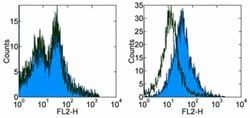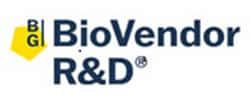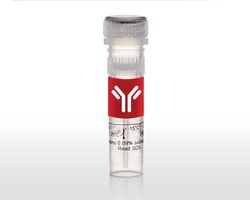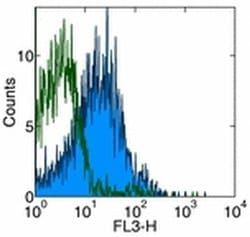50-148-23
CD279 (PD-1) Monoclonal Antibody (J43), Functional Grade, eBioscience™, Invitrogen™
Manufacturer: Fischer Scientific
Select a Size
| Pack Size | SKU | Availability | Price |
|---|---|---|---|
| Each of 1 | 50-148-23-Each-of-1 | In Stock | ₹ 37,291.00 |
50-148-23 - Each of 1
In Stock
Quantity
1
Base Price: ₹ 37,291.00
GST (18%): ₹ 6,712.38
Total Price: ₹ 44,003.38
Antigen
CD279 (PD-1)
Classification
Monoclonal
Concentration
1 mg/mL
Formulation
PBS with no preservative; pH 7.2
Gene Accession No.
Q02242
Gene Symbols
Pdcd1
Purification Method
Affinity chromatography
Regulatory Status
RUO
Gene ID (Entrez)
18566
Content And Storage
4° C
Form
Liquid
Applications
Flow Cytometry, Functional Assay
Clone
J43
Conjugate
Functional Grade
Gene
Pdcd1
Gene Alias
CD279; EGK_05005; hPD1; hPD-1; hPD-l; hSLE1; Ly101; mPD-1; PD1; PD-1; Pdc1; Pdcd1; programmed cell death 1; programmed cell death 1 protein; programmed cell death protein 1; programmed cell death protein 1-like; programmed death 1; Protein PD1; protein PD-1; sCD279; SLEB2; soluble CD279; systemic lupus erythematosus susceptibility 2
Host Species
Armenian Hamster
Quantity
500 μg
Primary or Secondary
Primary
Target Species
Mouse
Product Type
Antibody
Isotype
IgG
Description
- Description: The J43 monoclonal antibody reacts with mouse PD-1 (programmed death-1), a 55 kDa member of the Ig superfamily
- PD-1 contains the immunoreceptor tyrosine-based inhibitory motif (ITIM) and plays a key role in peripheral tolerance and autoimmune disease in mice
- PD-1 is expressed mainly on activated T and B lymphocytes
- Two novel B7 Family members have been identified as PD-1 ligands, PD-L1 (B7-H1) and PD-L2 (B7-DC)
- Evidence reported to date suggests overlapping functions for these ligands and their constitutive expression on some normal tissues and upregulation on activated antigen-presenting cells
- It is reported that J43 inhibits the binding of mouse PD-L1-Ig and mouse PD-L2-Ig to PD-1/BHK transfected cells
- When administrated in vivo, both intact and Fab of J43 are reported to enhance contact hypersensitivity and exacerbate acute GVHD similar to transfer of PD-1-deficient cells
- Injection of J43 also exacerbates EAE and NOD diabetes as do specific antibodies to mouse PD-L1 and PD-L2
- Applications Reported: The J43 antibody has been reported for use in flow cytometric analysis
- It has also been reported for use in in vitro functional assays
- Applications Tested: The J43 antibody has been tested by flow cytometric analysis of mouse Con-A activated spleen cells and mouse PD-1 transfected cells
- This can be used at less than or equal to 0.5 μg per test
- Cell-mediated immune responses are initiated by T lymphocytes that are themselves stimulated by cognate peptides bound to MHC molecules on antig en-presenting cells (APC)
- T-cell activation is generally self-limited as activated T cells express receptors such as PD-1 (also known as PDCD-1) that mediate inhibitory signals from the APC
- PD-1 can bind two different but related ligands, PDL-1 and PDL-2
- Upon binding to either of these ligands, signals generated by PD-1 inhibit the activation of the immune response in the absence of "edanger signals"e such as LPS or other molecules associated with bacteria or other pathogens
- Evidence for this is seen in PD1-null mice who exhibit hyperactivated immune systems and autoimmune diseases
- Despite its predicted molecular weight, PD-1 often migrates at higher molecular weight in SDS-PAGE.
Compare Similar Items
Show Difference
Antigen: CD279 (PD-1)
Classification: Monoclonal
Concentration: 1 mg/mL
Formulation: PBS with no preservative; pH 7.2
Gene Accession No.: Q02242
Gene Symbols: Pdcd1
Purification Method: Affinity chromatography
Regulatory Status: RUO
Gene ID (Entrez): 18566
Content And Storage: 4° C
Form: Liquid
Applications: Flow Cytometry, Functional Assay
Clone: J43
Conjugate: Functional Grade
Gene: Pdcd1
Gene Alias: CD279; EGK_05005; hPD1; hPD-1; hPD-l; hSLE1; Ly101; mPD-1; PD1; PD-1; Pdc1; Pdcd1; programmed cell death 1; programmed cell death 1 protein; programmed cell death protein 1; programmed cell death protein 1-like; programmed death 1; Protein PD1; protein PD-1; sCD279; SLEB2; soluble CD279; systemic lupus erythematosus susceptibility 2
Host Species: Armenian Hamster
Quantity: 500 μg
Primary or Secondary: Primary
Target Species: Mouse
Product Type: Antibody
Isotype: IgG
Antigen:
CD279 (PD-1)
Classification:
Monoclonal
Concentration:
1 mg/mL
Formulation:
PBS with no preservative; pH 7.2
Gene Accession No.:
Q02242
Gene Symbols:
Pdcd1
Purification Method:
Affinity chromatography
Regulatory Status:
RUO
Gene ID (Entrez):
18566
Content And Storage:
4° C
Form:
Liquid
Applications:
Flow Cytometry, Functional Assay
Clone:
J43
Conjugate:
Functional Grade
Gene:
Pdcd1
Gene Alias:
CD279; EGK_05005; hPD1; hPD-1; hPD-l; hSLE1; Ly101; mPD-1; PD1; PD-1; Pdc1; Pdcd1; programmed cell death 1; programmed cell death 1 protein; programmed cell death protein 1; programmed cell death protein 1-like; programmed death 1; Protein PD1; protein PD-1; sCD279; SLEB2; soluble CD279; systemic lupus erythematosus susceptibility 2
Host Species:
Armenian Hamster
Quantity:
500 μg
Primary or Secondary:
Primary
Target Species:
Mouse
Product Type:
Antibody
Isotype:
IgG
Antigen: __
Classification: __
Concentration: __
Formulation: __
Gene Accession No.: __
Gene Symbols: __
Purification Method: __
Regulatory Status: __
Gene ID (Entrez): __
Content And Storage: __
Form: __
Applications: __
Clone: __
Conjugate: __
Gene: __
Gene Alias: __
Host Species: __
Quantity: __
Primary or Secondary: __
Target Species: __
Product Type: __
Isotype: __
Antigen:
__
Classification:
__
Concentration:
__
Formulation:
__
Gene Accession No.:
__
Gene Symbols:
__
Purification Method:
__
Regulatory Status:
__
Gene ID (Entrez):
__
Content And Storage:
__
Form:
__
Applications:
__
Clone:
__
Conjugate:
__
Gene:
__
Gene Alias:
__
Host Species:
__
Quantity:
__
Primary or Secondary:
__
Target Species:
__
Product Type:
__
Isotype:
__
Antigen: CD184 (CXCR4)
Classification: Monoclonal
Concentration: 1 mg/mL
Formulation: PBS with no preservative; pH 7.2
Gene Accession No.: P70658
Gene Symbols: Cxcr4
Purification Method: Affinity chromatography
Regulatory Status: RUO
Gene ID (Entrez): 12767
Content And Storage: 4° C
Form: Liquid
Applications: Flow Cytometry, Functional Assay
Clone: 2B11
Conjugate: Functional Grade
Gene: Cxcr4
Gene Alias: b2b220Clo; C Cmotif chemokine; C X C motif chemokine; CC motif chemokine; CCmotif chemokine; CD antigen CD184; CD184; CD184 antigen; chemokine (C-X-C motif) receptor 4; chemokine (C-X-C) receptor 4; chemokine receptor; chemokine receptor (LCR1); chemokine receptor 4; chemokine receptor CXCR4; Cmkar4; CXC; CXC chemokine receptor; C-X-C chemokine receptor type 4; CXC motif chemokine; C-X-C motif chemokine receptor 4; CXCR4; CXC-R4; CXCR-4; D2S201E; FB22; Fusin; HM89; HSY3RR; HUMSTR; LAP3; LAP-3; LCR1; LESTR; Leukocyte-derived seven transmembrane domain receptor; leukocyte-expressed seven-transmembrane-domain; lipopolysaccharide-associated protein 3; LPS-associated protein 3; neuropeptide Y receptor Y3; neuropeptide Y3 receptor; NPY3R; NPYR; NPYRL; NPYY3R; PB-CKR; PBSF/SDF-1; pre-B-cell-derived chemokine receptor; SDF-1 receptor; Sdf1r; seven transmembrane helix receptor; seven-transmembrane-segment receptor, spleen; stromal cell-derived factor 1 receptor; WHIM; WHIMS
Host Species: Rat
Quantity: 500 μg
Primary or Secondary: Primary
Target Species: Mouse
Product Type: Antibody
Isotype: IgG2b κ
Antigen:
CD184 (CXCR4)
Classification:
Monoclonal
Concentration:
1 mg/mL
Formulation:
PBS with no preservative; pH 7.2
Gene Accession No.:
P70658
Gene Symbols:
Cxcr4
Purification Method:
Affinity chromatography
Regulatory Status:
RUO
Gene ID (Entrez):
12767
Content And Storage:
4° C
Form:
Liquid
Applications:
Flow Cytometry, Functional Assay
Clone:
2B11
Conjugate:
Functional Grade
Gene:
Cxcr4
Gene Alias:
b2b220Clo; C Cmotif chemokine; C X C motif chemokine; CC motif chemokine; CCmotif chemokine; CD antigen CD184; CD184; CD184 antigen; chemokine (C-X-C motif) receptor 4; chemokine (C-X-C) receptor 4; chemokine receptor; chemokine receptor (LCR1); chemokine receptor 4; chemokine receptor CXCR4; Cmkar4; CXC; CXC chemokine receptor; C-X-C chemokine receptor type 4; CXC motif chemokine; C-X-C motif chemokine receptor 4; CXCR4; CXC-R4; CXCR-4; D2S201E; FB22; Fusin; HM89; HSY3RR; HUMSTR; LAP3; LAP-3; LCR1; LESTR; Leukocyte-derived seven transmembrane domain receptor; leukocyte-expressed seven-transmembrane-domain; lipopolysaccharide-associated protein 3; LPS-associated protein 3; neuropeptide Y receptor Y3; neuropeptide Y3 receptor; NPY3R; NPYR; NPYRL; NPYY3R; PB-CKR; PBSF/SDF-1; pre-B-cell-derived chemokine receptor; SDF-1 receptor; Sdf1r; seven transmembrane helix receptor; seven-transmembrane-segment receptor, spleen; stromal cell-derived factor 1 receptor; WHIM; WHIMS
Host Species:
Rat
Quantity:
500 μg
Primary or Secondary:
Primary
Target Species:
Mouse
Product Type:
Antibody
Isotype:
IgG2b κ
Antigen: CD184 (CXCR4)
Classification: Monoclonal
Concentration: 1 mg/mL
Formulation: PBS with no preservative; pH 7.2
Gene Accession No.: P61073
Gene Symbols: Cxcr4
Purification Method: Affinity chromatography
Regulatory Status: RUO
Gene ID (Entrez): 7852
Content And Storage: 4° C
Form: Liquid
Applications: Flow Cytometry, Functional Assay, Neutralization
Clone: 12G5
Conjugate: Functional Grade
Gene: Cxcr4
Gene Alias: b2b220Clo; C Cmotif chemokine; C X C motif chemokine; CC motif chemokine; CCmotif chemokine; CD antigen CD184; CD184; CD184 antigen; chemokine (C-X-C motif) receptor 4; chemokine (C-X-C) receptor 4; chemokine receptor; chemokine receptor (LCR1); chemokine receptor 4; chemokine receptor CXCR4; Cmkar4; CXC; CXC chemokine receptor; C-X-C chemokine receptor type 4; CXC motif chemokine; C-X-C motif chemokine receptor 4; CXCR4; CXC-R4; CXCR-4; D2S201E; FB22; Fusin; HM89; HSY3RR; HUMSTR; LAP3; LAP-3; LCR1; LESTR; Leukocyte-derived seven transmembrane domain receptor; leukocyte-expressed seven-transmembrane-domain; lipopolysaccharide-associated protein 3; LPS-associated protein 3; neuropeptide Y receptor Y3; neuropeptide Y3 receptor; NPY3R; NPYR; NPYRL; NPYY3R; PB-CKR; PBSF/SDF-1; pre-B-cell-derived chemokine receptor; SDF-1 receptor; Sdf1r; seven transmembrane helix receptor; seven-transmembrane-segment receptor, spleen; stromal cell-derived factor 1 receptor; WHIM; WHIMS
Host Species: Mouse
Quantity: 50 μg
Primary or Secondary: Primary
Target Species: Human
Product Type: Antibody
Isotype: IgG2a κ
Antigen:
CD184 (CXCR4)
Classification:
Monoclonal
Concentration:
1 mg/mL
Formulation:
PBS with no preservative; pH 7.2
Gene Accession No.:
P61073
Gene Symbols:
Cxcr4
Purification Method:
Affinity chromatography
Regulatory Status:
RUO
Gene ID (Entrez):
7852
Content And Storage:
4° C
Form:
Liquid
Applications:
Flow Cytometry, Functional Assay, Neutralization
Clone:
12G5
Conjugate:
Functional Grade
Gene:
Cxcr4
Gene Alias:
b2b220Clo; C Cmotif chemokine; C X C motif chemokine; CC motif chemokine; CCmotif chemokine; CD antigen CD184; CD184; CD184 antigen; chemokine (C-X-C motif) receptor 4; chemokine (C-X-C) receptor 4; chemokine receptor; chemokine receptor (LCR1); chemokine receptor 4; chemokine receptor CXCR4; Cmkar4; CXC; CXC chemokine receptor; C-X-C chemokine receptor type 4; CXC motif chemokine; C-X-C motif chemokine receptor 4; CXCR4; CXC-R4; CXCR-4; D2S201E; FB22; Fusin; HM89; HSY3RR; HUMSTR; LAP3; LAP-3; LCR1; LESTR; Leukocyte-derived seven transmembrane domain receptor; leukocyte-expressed seven-transmembrane-domain; lipopolysaccharide-associated protein 3; LPS-associated protein 3; neuropeptide Y receptor Y3; neuropeptide Y3 receptor; NPY3R; NPYR; NPYRL; NPYY3R; PB-CKR; PBSF/SDF-1; pre-B-cell-derived chemokine receptor; SDF-1 receptor; Sdf1r; seven transmembrane helix receptor; seven-transmembrane-segment receptor, spleen; stromal cell-derived factor 1 receptor; WHIM; WHIMS
Host Species:
Mouse
Quantity:
50 μg
Primary or Secondary:
Primary
Target Species:
Human
Product Type:
Antibody
Isotype:
IgG2a κ



